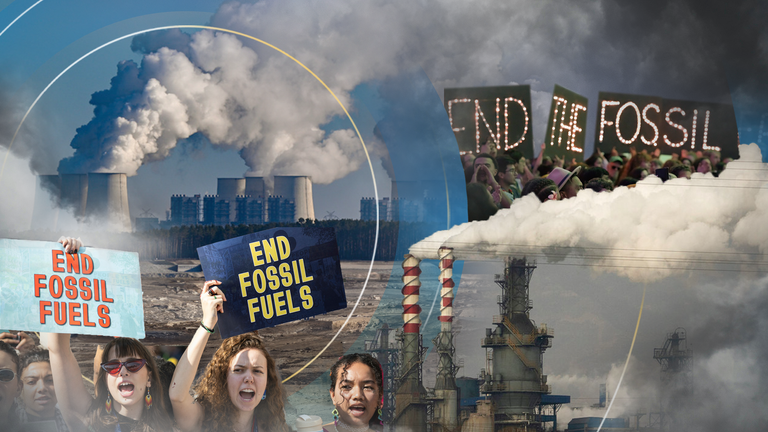It’s 13 December 2023. Excited reports of a “landmark” global climate agreement reverberate around the world from the COP28 climate summit in Dubai.
At around 11am, weary diplomats with circles under their eyes from fierce, all-night negotiations cheer, cry and hug.
The US’s climate envoy John Kerry throws his arms around German foreign minister Annalena Baerbock. There’s a round of applause for Tina Stege, a fierce representative from the Marshall Islands who had fought among the hardest for the pledge.
They and more than 190 other countries have just agreed to “transition away from fossil fuels” – the culmination of a fraught two weeks of talks at the UN conference.
This may not sound very “historic”, given burning fossil fuels is the number one cause of climate change, and these annual talks had been going on for almost 30 years.
But no pact had ever even mentioned the words “fossil fuels” before – not even the historic Paris Agreement. It had always faced opposition from economies that rely on fossil fuels, like Russia and Saudi Arabia.
This was the first time these countries could stomach such a commitment – and it was hard won.
Several countries had fought tooth and nail to keep such words out of the final agreement, now known as the “UAE Consensus”.
They had also battled over a pledge to triple renewable energy by 2030, but that cinched its way into the pact too.
Fast forward to this year, as we approach COP29 in Azerbaijan in November, it’s now possible to tell whether countries have stuck to their pledge – or whether it was all hot air.
And there is something surprising going on.
The good news
Let’s start with what’s going well: an explosion in renewable electricity.
The world’s leading energy authority, the International Energy Agency, recently produced its annual report tracking energy trends.
Sky News analysis of this data finds the amount of renewable power forecast for 2030 has jumped by 13%, compared with last year’s forecast.
Power generated by renewables like solar and wind is on course to soar from around 4,250 GW today to nearly 10,000 GW in 2030.
That’s not quite a tripling, but an increase of 2.3 times at least.
How’s the ‘transition away from fossil fuels’ going?
You would think the growth of renewable electricity would mean a drop in the amount of fossil fuel power.
But, to the dismay of some analysts, the amount the world is forecast to use in 2030 has shown no improvement in comparison with last year’s forecast.
And projected coal use in 2030 has actually increased since that pledge.
We’re now likely to burn 10% more coal in 2030 than anticipated this time last year.
So although coal, oil and gas are still on course to peak before 2030 – that’s good – their decline looks slower than expected.
That means emissions of greenhouse gases, which are about to peak, will also be higher for longer.
Countries for whom this may be matter of life and death, such as low-lying island states, are enraged by the paltry progress.
“Small island states despair that we are waiting in vain to see the sharp decline in fossil fuel production that was heralded,” said Samoa’s Dr Pa’olelei Luteru, who represents a vulnerable group of small island nations known as AOSIS.
“Alas, saying something is one thing and actually meaning it is quite another.”
But why haven’t all these renewable power plans made more of a dent in projected fossil fuel use?
The problem of our ‘insatiable demand for energy’
Although renewables are exploding in many parts of the world, so is our energy demand.
Dave Jones from energy thinktank Ember said what “got me” in the report was that the world is “continuing to use more total energy than anyone was really expecting”.
In 2035 the world’s electricity demand is going to be a significant 6% higher than anticipated last year, the IEA said as it revised up its forecast.
That means the surge in renewable electricity just can’t keep up.
This should be “a wake-up call”, said Jones. “Are we going to be able to change that trajectory of our rising, insatiable demand?”
Of course, some of that increase was expected.
Camilla Born, who has advised various COP presidencies, including the UAE last year, said demand increase was “always going to be there” as countries develop.
Also, it’s an indication of the different industries we’re moving into, like electric heat pumps and cars.
But there is something else disrupting forecasts.
The rise and rise of air conditioning and AI
Power-hungry air conditioning has absolutely boomed in the last year, as both incomes and temperatures rise, especially in emerging economies like India and China.
India has been baked by severe heatwaves for the last three years in a row, with one this year lasting a record 24 days.
By 2035 global energy demand for air conditioning is due to rise by an amount greater than the entire Middle East’s electricity use today.
The problem is not necessarily that people need to stay cool in a hotter world, but that many are buying units that use double the amount of energy than they need to – something that can be improved with the right policies.
But it’s not just about emerging economies, it’s actually “an everywhere story”, said Jones, with demand now growing more again in developed countries too.
On top of this, as our use of artificial intelligence proliferates, a “substantial increase in electricity consumption from data centres appears inevitable”, said the International Energy Agency (IEA).
Another goal from last year, to double the rate of energy efficiency improvements, has the potential to lower emissions by 2030 by more than anything else, said the IEA.
But in a damming indictment, that pledge “looks far out of reach under today’s policy settings”, it said.
Jones said we should be trying to work out “how we can go through this transition less wastefully than we are today”.
An alternative way to measure progress on that pledge is by investigating what impact countries’ current climate plans will have on greenhouse gas emissions, which cause climate change.
These plans will see emissions in 2030 just 2.6% lower than in 2019, the UN’s climate body (UNFCCC) found in October. Last year forecast a 2% fall.
It’s “marginal” progress, but nowhere near the 43% reduction that scientists say we need. New plans are due by February and will also test the pledge, but some countries are already rowing back.
Saudi Arabia has claimed it was actually just one option on a “menu”, while G20 members have argued about whether to include it in their own agreements this year.
So did the fossil fuel pledge mean anything?
But Born said the agreement at COP28 in Dubai was a “reflection of where we were already” as the shift off polluting fossil fuels had already begun.
“It just is very evident how bumpy and challenging that transition away is going to be.”
And countries wouldn’t fight so hard over pledges if they meant nothing.
Before the historic Paris Agreement was struck at COP21 in 2015, the world was on course for around 4C of warming. Now it’s between 2.6-3.1C – still extortionate, but better. Since then, the global pipeline of coal power plants has collapsed by 72% and the cost of solar has plummeted by 90%.
Born said although that’s still not enough, “the fact that [the transition] is happening, rather than being just forecast to happen at some point, is a very different story that we’re telling these days”.
What’s next?
The next summit, COP29, starts in Baku, Azerbaijan, on 11 November.
A test of ongoing backing for the “transition away” pledge will be whether it makes it into this year’s final agreement.
Host nation Azerbaijan – a major oil and gas producer – seems keen to gloss over the hydrocarbon conundrum.
Its lead negotiator Yalchin Rafiyev recently told journalists: “We want to have a balanced [agreement], but at the same time… Each COP has some main expected deliverables. This year it’s finance.”
And it’s true, COP29 has been dubbed the “finance COP” because its primary aim is to agree a new fund – aka the New Collective Quantified Goal – to pay for climate measures in developing countries.
The more money, the faster poorer nations can afford to ditch fossil fuels.
Tasneem Essop, of Climate Action Network which represents more than 1,000 global environmental NGOs, said: “Developing countries are not receiving the critical support they need, and this is why COP29 must deliver an ambitious climate finance goal.”
She added: “The time to act is now. Our future depends on it.”



























